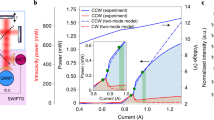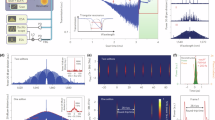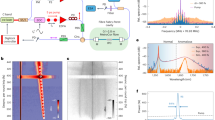Abstract
Laser sources power ultrafast data transmission, computing acceleration, access to ultra-high-speed signalling, and sensing applications such as chemical detection, distance measurements and pattern recognition. The ever-growing scale of these applications drives innovation in multiwavelength lasers for massively parallel processing. We report a nanophotonic Kerr-resonator circuit that converts the power of an input laser into a normal-dispersion soliton frequency comb at approaching unit efficiency. By coupling forward and backward propagation, we realize a bidirectional Kerr resonator that supports universal phase matching but also opens excess loss by double-sided emission. We therefore induce reflection of the resonator’s forward, external coupling port to favour backward propagation, resulting in efficient, unidirectional soliton formation. Coherent backscattering with nanophotonics provides the control to put arbitrary phase-matching and efficient laser power consumption on equal footing in Kerr resonators. In the overcoupled-resonator regime, we measure 65% conversion efficiency for a 40 mW input pump laser; the nonlinear circuit consumes 97% of the pump, generating the maximum possible comb power. Our work opens up high-efficiency soliton formation in integrated photonics, exploring how energy flows in nonlinear circuits and enabling laser sources for applications such as advanced transmission, computing, quantum sensing and artificial intelligence.
This is a preview of subscription content, access via your institution
Access options
Access Nature and 54 other Nature Portfolio journals
Get Nature+, our best-value online-access subscription
$32.99 / 30 days
cancel any time
Subscribe to this journal
Receive 12 print issues and online access
$259.00 per year
only $21.58 per issue
Buy this article
- Purchase on SpringerLink
- Instant access to full article PDF
Prices may be subject to local taxes which are calculated during checkout




Similar content being viewed by others
Data availability
Source Data are provided with this paper. Further data are available from the corresponding author on reasonable request.
Code availability
The simulation codes used in this study are available from the corresponding author on reasonable request.
References
Willner, A. E., Khaleghi, S., Chitgarha, M. R. & Yilmaz, O. F. All-optical signal processing. J. Lightwave Technol. 32, 660–680 (2014).
Carlson, D. R. et al. Ultrafast electro-optic light with subcycle control. Science 361, 1358–1363 (2018).
Hansryd, J., Andrekson, P., Westlund, M., Li, J. & Hedekvist, P.-O. Fiber-based optical parametric amplifiers and their applications. IEEE J. Sel. Topics Quant. Electron. 8, 506–520 (2002).
Foster, M. A. et al. Broad-band optical parametric gain on a silicon photonic chip. Nature 441, 960–963 (2006).
Riemensberger, J. et al. A photonic integrated continuous-travelling-wave parametric amplifier. Nature 612, 56–61 (2022).
Dutt, A. et al. On-chip optical squeezing. Phys. Rev. Appl. 3, 044005 (2015).
Reimer, C. et al. Generation of multiphoton entangled quantum states by means of integrated frequency combs. Science 351, 1176–1180 (2016).
Yang, Z. et al. A squeezed quantum microcomb on a chip. Nat. Commun. 12, 4781 (2021).
Guidry, M. A., Lukin, D. M., Yang, K. Y., Trivedi, R. & Vučkovic`, J. Quantum optics of soliton microcombs. Nat. Photon. 16, 52–58 (2022).
Jahanbozorgi, M. et al. Generation of squeezed quantum microcombs with silicon nitride integrated photonic circuits. Optica 10, 1100–1101 (2023).
Kippenberg, T. J., Holzwarth, R. & Diddams, S. A. Microresonator-based optical frequency combs. Science 332, 555–559 (2011).
Moss, D. J., Morandotti, R., Gaeta, A. L. & Lipson, M. New cmos-compatible platforms based on silicon nitride and hydex for nonlinear optics. Nat. Photon. 7, 597–607 (2013).
Pasquazi, A. et al. Micro-combs: a novel generation of optical sources. Phys. Rep. 729, 1–81 (2018).
Kippenberg, T. J., Gaeta, A. L., Lipson, M. & Gorodetsky, M. L. Dissipative Kerr solitons in optical microresonators. Science 361, eaan8083 (2018).
Gaeta, A. L., Lipson, M. & Kippenberg, T. J. Photonic-chip-based frequency combs. Nat. Photon. 13, 158–169 (2019).
Ji, X. et al. Ultra-low-loss on-chip resonators with sub-milliwatt parametric oscillation threshold. Optica 4, 619–624 (2017).
Lu, X., Moille, G., Rao, A., Westly, D. A. & Srinivasan, K. On-chip optical parametric oscillation into the visible: generating red, orange, yellow, and green from a near-infrared pump. Optica 7, 1417–1425 (2020).
Black, J. A. et al. Optical-parametric oscillation in photonic-crystal ring resonators. Optica 9, 1183–1189 (2022).
Perez, E. F. et al. High-performance Kerr microresonator optical parametric oscillator on a silicon chip. Nat. Commun. 14, 242 (2023).
Herr, T. et al. Temporal solitons in optical microresonators. Nat. Photon. 8, 145–152 (2014).
Yi, X., Yang, Q.-F., Yang, K. Y., Suh, M.-G. & Vahala, K. Soliton frequency comb at microwave rates in a high-Q silica microresonator. Optica 2, 1078–1085 (2015).
Xu, G. et al. Spontaneous symmetry breaking of dissipative optical solitons in a two-component kerr resonator. Nat. Commun. 12, 4023 (2021).
Yu, S.-P. et al. Spontaneous pulse formation in edgeless photonic crystal resonators. Nat. Photon. 15, 461–467 (2021).
Yu, S.-P., Lucas, E., Zang, J. & Papp, S. B. A continuum of bright and dark-pulse states in a photonic-crystal resonator. Nat. Commun. 13, 3134 (2022).
Lucas, E., Yu, S.-P., Briles, T. C., Carlson, D. R. & Papp, S. B. Tailoring microcombs with inverse-designed, meta-dispersion microresonators. Nat. Photon. 17, 943–950 (2023).
Shen, B. et al. Integrated turnkey soliton microcombs. Nature 582, 365–369 (2020).
Voloshin, A. S. et al. Dynamics of soliton self-injection locking in optical microresonators. Nat. Commun. 12, 235 (2021).
Xiang, C. et al. Laser soliton microcombs heterogeneously integrated on silicon. Science 373, 99–103 (2021).
Briles, T. C. et al. Hybrid InP and SiN integration of an octave-spanning frequency comb. APL Photon. 6, 026102 (2021).
Ulanov, A. E. et al. Synthetic reflection self-injection-locked microcombs. Nat. Photon. 18, 294–299 (2024).
Yang, K. Y. et al. Multi-dimensional data transmission using inverse-designed silicon photonics and microcombs. Nat. Commun. 13, 7862 (2022).
Rizzo, A. et al. Massively scalable Kerr comb-driven silicon photonic link. Nat. Photon. 17, 781–790 (2023).
Tan, M. et al. Photonic RF and microwave filters based on 49 GHz and 200 GHz Kerr microcombs. Optics Commun. 465, 125563 (2020).
Xue, X., Zheng, X. & Zhou, B. Super-efficient temporal solitons in mutually coupled optical cavities. Nat. Photon. 13, 616–622 (2019).
Bao, H. et al. Laser cavity-soliton microcombs. Nat. Photon. 13, 384–389 (2019).
Cole, D. C., Lamb, E. S., Del’Haye, P., Diddams, S. A. & Papp, S. B. Soliton crystals in Kerr resonators. Nat. Photon. 11, 671–676 (2017).
Helgason, Ó. B. et al. Surpassing the nonlinear conversion efficiency of soliton microcombs. Nat. Photon. 17, 992–999 (2023).
Girardi, M., Helgason, Ó. B., Ortega, C. H. L., Rebolledo-Salgado, I. & Torres-Company, V. Superefficient microcombs at the wafer level. Preprint at https://arxiv.org/abs/2309.02280 (2023).
Xue, X. et al. Mode-locked dark pulse kerr combs in normal-dispersion microresonators. Nat. Photon. 9, 594–600 (2015).
Xue, X., Wang, P.-H., Xuan, Y., Qi, M. & Weiner, A. M. Microresonator Kerr frequency combs with high conversion efficiency. Laser Photon. Rev. 11, 1600276 (2017).
Kim, B. Y. et al. Turn-key, high-efficiency Kerr comb source. Opt. Lett. 44, 4475–4478 (2019).
Helgason, Ó. B. et al. Dissipative solitons in photonic molecules. Nat. Photon. 15, 305–310 (2021).
White, A. D. et al. Integrated passive nonlinear optical isolators. Nat. Photon. 17, 143–149 (2023).
Bogaerts, W. et al. Silicon-on-insulator spectral filters fabricated with cmos technology. IEEE J. Sel. Top. Quantum Electronics 16, 33–44 (2010).
Dai, D. Silicon nanophotonic integrated devices for on-chip multiplexing and switching. J. Lightwave Technol. 35, 572–587 (2017).
Lamee, K. F., Carlson, D. R., Newman, Z. L., Yu, S.-P. & Papp, S. B. Nanophotonic tantala waveguides for supercontinuum generation pumped at 1560 nm. Optics Lett. 45, 4192–4195 (2020).
Jung, H. et al. Tantala kerr nonlinear integrated photonics. Optica 8, 811–817 (2021).
Black, J. A. et al. Group-velocity-dispersion engineering of tantala integrated photonics. Optics Lett. 46, 817–820 (2021).
Lugiato, L. A. & Lefever, R. Spatial dissipative structures in passive optical systems. Phys. Rev. Lett. 58, 2209–2211 (1987).
Skryabin, D. V. Hierarchy of coupled mode and envelope models for bi-directional microresonators with kerr nonlinearity. OSA Continuum 3, 1364–1375 (2020).
Liu, H. et al. Threshold and laser conversion in nanostructured-resonator parametric oscillators. Phys. Rev. Lett. 132, 023801 (2024).
Shirpurkar, C. et al. Photonic crystal resonators for inverse-designed multi-dimensional optical interconnects. Optics Lett. 47, 3063–3066 (2022).
Acknowledgements
We thank A. Dan and Y. Li for reading the manuscript. This work is a contribution of NIST and not subject to US copyright. This research has been funded by DARPA PIPES (J.Z., S.-P.Y., H.L., Y.J., S.B.P.), AFOSR FA9550-20-1-0004 project no. 19RT1019 (S.B.P.), NSF Quantum Leap Challenge Institute Award OMA-2016244 (S.B.P.), and NIST on a Chip (S.B.P.). Mention of specific companies or trade names is for scientific communication only and does not constitute an endorsement by NIST.
Author information
Authors and Affiliations
Contributions
S.-P.Y. conceived the experiment. S.-P.Y. and J.Z. designed the nanophotonic circuit. J.Z. performed the optical measurements and numerical simulations. H. L. and Y. J. contributed to the theoretical understanding. T.C.B. and D.R.C. fabricated the nanophotonic circuits. S.B.P. contributed to the theoretical understanding and supervised the project. J.Z. and S.B.P analysed the data and wrote the manuscript. All authors reviewed the results and provided feedback on the manuscript.
Corresponding author
Ethics declarations
Competing interests
The authors declare no competing interests.
Peer review
Peer review information
Nature Photonics thanks Xiaoxiao Xue and the other, anonymous, reviewer(s) for their contribution to the peer review of this work.
Additional information
Publisher’s note Springer Nature remains neutral with regard to jurisdictional claims in published maps and institutional affiliations.
Supplementary information
Supplementary Information
Supplementary Sections 1–7.
Supplementary Data
Source Data for Supplementary Figs. 1–6.
Source data
Source Data Fig. 1
Source Data for Fig. 1.
Source Data Fig. 2
Source Data for Fig. 2.
Source Data Fig. 3
Source Data for Fig. 3.
Source Data Fig. 4
Source Data for Fig. 4.
Rights and permissions
Springer Nature or its licensor (e.g. a society or other partner) holds exclusive rights to this article under a publishing agreement with the author(s) or other rightsholder(s); author self-archiving of the accepted manuscript version of this article is solely governed by the terms of such publishing agreement and applicable law.
About this article
Cite this article
Zang, J., Yu, SP., Liu, H. et al. Laser power consumption of soliton formation in a bidirectional Kerr resonator. Nat. Photon. 19, 510–517 (2025). https://doi.org/10.1038/s41566-025-01624-1
Received:
Accepted:
Published:
Issue date:
DOI: https://doi.org/10.1038/s41566-025-01624-1
This article is cited by
-
The bandgap-detuned excitation regime in photonic-crystal resonators
Nature Communications (2025)
-
320 GHz photonic-electronic analogue-to-digital converter (ADC) exploiting Kerr soliton microcombs
Light: Science & Applications (2025)
-
Integrated multi-port multi-wavelength coherent optical source for beyond Tb/s optical links
Nature Communications (2025)



